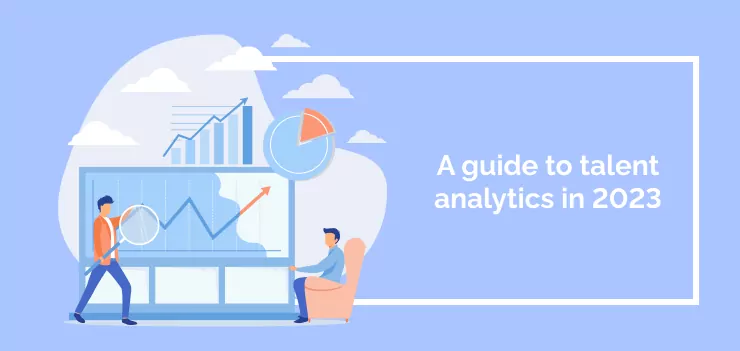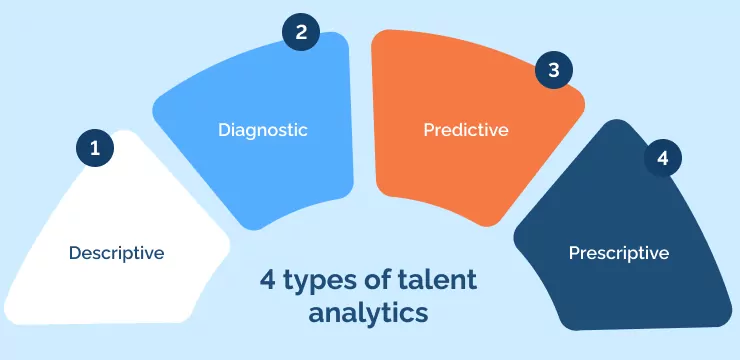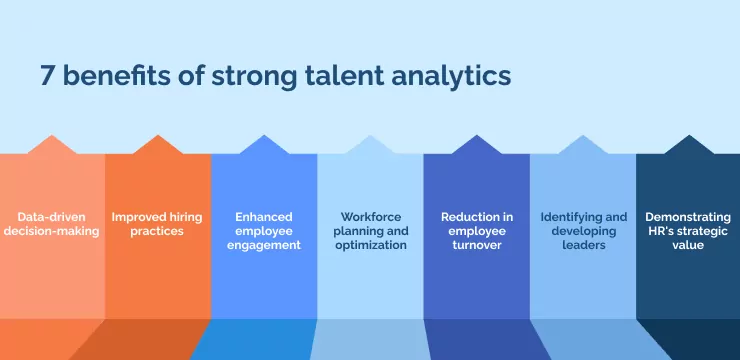
Talent analytics is when a business uses digital technology to collect and analyze employee data with the goal of making better HR decisions. The insights gleaned from talent analytics can improve employee experience, engagement, and productivity.
It can also help you navigate successful change management.
You may see talent analytics referred to as “workforce analytics,” “human capital analytics,” or “HR analytics,”— but rest assured, it’s all the same thing.
The importance of data analytics has permeated every part of the modern, digital-first business. HR is no exception.
HR once required organized, empathetic individuals with great soft skills. And a successful HR professional still needs all those traits— but now they need much more.
“…what HR is demanding now is being numerate, understanding the value tree, really knowing how to use analytics”, says Bill Schaninger, Senior Partner at Mckinsey.
The benefits of strong talent analytics capabilities are real and tangible. Research by Bain & Company in 2021 found that businesses that had invested in talent analytics were 40% more productive.
And yet, according to Oracle’s State of HR Analytics 2021, less than a third of businesses are using talent analytics effectively.
In this article, we’re sharing everything you need to know about talent analytics so you can be the third of businesses that reap the benefits.
We’ll look at talent analytics in more depth, how it works, and how you can get started with talent analytics in your own business.
When you’re done reading, you’ll be primed to use talent analytics to create a business where employees and potential candidates love to work.
What is talent analytics?
Let’s start by exploring talent analytics in a little more detail.
Talent analytics is a dynamic approach that makes it possible to sift through vast amounts of employee data to find patterns and insights that inform recruitment, management, and retention strategies.
By studying and analyzing this data, you can discover valuable information about your workforce, such as their level of engagement, performance abilities, and growth potential.
By using talent analytics, you’ll be well-positioned to respond quickly to disruptive changes in the market and gain a competitive edge where your competitors panic.
Predicting trends in the workforce can help HR managers to better recruit new talent and retain current employees.
4 types of talent analytics

Talent analytics can be generally separated into 4 distinct types.
These 4 types often form a progression— you’d begin with the first and incorporate the later types as your business’s talent analytics capabilities improve.
The 4 types of talent analytics are:
- Descriptive
This is the most basic level of talent analytics and involves gathering and interpreting historical data.
It helps to describe the current state of your organization by analyzing data on hiring, turnover, employee retention, etc.
The goal is to provide insights into what has happened in the past.
- Diagnostic
This type of analytics seeks to understand the causes of past outcomes.
It involves more detailed data analysis techniques like correlations and data mining to identify patterns and relationships between different factors.
Diagnostic analytics helps answer questions like “Why did a specific outcome happen?”
- Predictive
As the name suggests, predictive analytics uses statistical techniques and machine learning models to forecast future outcomes based on historical data.
It might involve predicting employee attrition, identifying future high performers, forecasting workforce demand, and more.
- Prescriptive
This is the most advanced form of talent analytics.
It predicts future outcomes and suggests actions to benefit from these predictions.
Prescriptive analytics uses optimization, simulation, and decision-modeling techniques to guide decision-making.
For example, it might suggest the best strategies for improving employee experience or reducing turnover based on predictive analysis.
Commonly measured metrics in talent analytics

Within the different types of talent analytics, there are the metrics themselves.
These metrics comprise the data you collect to enrich your talent analytics program.
The data you choose to measure will depend on your specific business needs, so we can’t list every possible metric. But here are a few of the commonly used metrics in talent analytics to give you an idea of what to expect:
Time to fill
Time to fill measures the total time is taken to fill a job vacancy, from when the job is posted until an offer is accepted.
This metric can provide insights into the efficiency of the recruitment process.
Cost per hire
Cost per hire includes all costs associated with filling a job vacancy, such as advertising costs, recruitment agency fees, and the time internal staff spends on hiring activities.
This metric can help you understand the financial impact of your hiring practices.
Employee turnover rate
Employee turnover rate measures the number of employees who leave your organization over a given period, usually expressed as a percentage of the total workforce.
High turnover can be costly and disruptive, so this is a critical metric for most businesses.
Employee engagement
Employee engagement measures employees’ commitment to their work and their organization.
Engaged employees are more likely to be productive and less likely to leave, making this a key metric for many organizations.
Absence rate
Absence rate measures the frequency and duration of employee absences, excluding planned absences such as vacation.
High absence rates can indicate employees’ low morale or poor health and well-being.
Performance metrics
Performance metrics measure how well employees are meeting their job requirements.
These can include quantitative metrics (such as sales targets) and qualitative metrics (such as feedback from supervisors or peers).
Talent mobility
Talent mobility measures the movement of employees within an organization, such as transfers, promotions, or lateral moves.
High talent mobility is a sign of a dynamic, adaptable workforce.
Diversity and inclusion
Diversity and inclusion metrics can include the representation of different groups within the workforce, pay equity, and employee perceptions of fairness and inclusion.
These metrics can help you create an equitable and inclusive workplace.
7 benefits of strong talent analytics

Businesses have known for a long time that people are their most valuable asset.
Talent analytics helps you get more out of (and take care of) that critical asset.
“I think that the key thing is to separate the signal from the noise,” says David Green, author of Excellence in People Analytics. “It can help organizations understand if they actually have a problem with attrition and, if so, where, what job families, what locations?”
We’ve touched on what you stand to gain by building your talent analytics capabilities, but let’s look at the top 7 benefits of talent analytics in more detail:
- Data-driven decision-making
With talent analytics, decisions about human resources are grounded in factual data rather than intuitive guesses or subjective opinions.
A data-driven approach promotes more objective, reliable, and transparent decisions about hiring, promotions, compensation, and beyond.
- Improved hiring practices
Talent analytics enables you to identify the traits that lead to successful job performance, allowing you to target these qualities during the recruitment process.
This can lead to improved quality of hires, reduced time-to-hire, and decreased turnover.
- Enhanced employee engagement
By pinpointing factors that contribute to employee productivity and satisfaction, talent analytics can help you create a better working environment.
This can lead to higher levels of employee engagement, potentially improving productivity and reducing turnover.
- Workforce planning and optimization
Talent analytics can project workforce demand based on business growth, turnover rates, and market trends.
This allows you to plan for future hiring needs and ensures you place the right people in the right roles at the right time.
- Reduction in employee turnover
By identifying risk factors for employee attrition, talent analytics empowers you to proactively intervene to retain top talent.
This can reduce the costs associated with high turnover, including recruitment, training, and lost productivity.
- Identifying and developing leaders
Talent analytics can aid in the identification of employees with high leadership potential, allowing you to focus your development efforts effectively.
This can ensure a robust pipeline of future leaders and contribute to the long-term success of your business.
- Demonstrating HR’s strategic value
By providing actionable insights that contribute to business success, talent analytics can demonstrate the strategic value of HR to business leaders.
There’s potential to change perspectives so people stop seeing HR as “just a cost” but as a primary driver of growth for your business.
Is there a downside to talent analytics?
Why are so few businesses doing this if the benefits are so significant?
As with any powerful digital function, there are downsides that often act as a barrier to adoption. It’s important to be aware of these so you have realistic expectations and aren’t caught off guard later.
Here are a few downsides of talent analytics to think about:
Complexity and cost of implementation
Implementing talent analytics can be complex and costly.
It requires investment in data collection, storage, analysis tools, and skilled analysts who can interpret the data.
Smaller organizations, in particular, may struggle with the resources needed for effective talent analytics.
Data privacy and security concerns
Talent analytics involves collecting and handling sensitive employee data, which raises privacy and security concerns.
You must comply with all relevant data protection laws and best practices to protect employee privacy and prevent data breaches.
Risk of bias
While talent analytics aims to make more objective decisions, it can inadvertently promote bias if the data is biased.
For example, if past hiring decisions have favored a certain group, predictive analytics models based on that data could continue to favor that group in the future.
Over-reliance on data
While data-driven decision-making is generally good, there’s a risk of over-relying on data at the expense of human judgment.
Data can provide valuable insights but can’t capture every nuance of human behavior or organizational culture.
Difficulty in capturing qualitative data
While quantitative data (like turnover rates or time to fill) is relatively straightforward to collect and analyze, qualitative data (like employee satisfaction or cultural fit) can be harder to capture accurately.
This can make it difficult to get a complete picture of some aspects of talent management.
There are digital tools available to help with this, but it’s as much an art as it is a science.
Resistance to change
Like any change, the introduction of talent analytics can be met with resistance from employees or managers who are used to doing things a certain way.
Therefore, Effective change management is essential to ensure the successful implementation of talent analytics.
Talent analytics: Worth investing in? Or too much trouble?
In the long term, talent analytics is inevitable.
Businesses with strong talent analytics capabilities use it to carve out a competitive advantage.
But:
As digital tools become more sophisticated and accessible, it will be easier for more businesses to develop strong talent analytics capabilities.
With that, the competitive distance will decrease.
Eventually, you’ll need talent analytics to keep up with the competition.
Furthermore, talent analytics is a process that requires investment— the earlier you start, the more quickly you’ll develop your capabilities and empower your business to make data-driven, intuition-backed decisions that turn employee attrition into attraction.
WalkMe Team
WalkMe spearheaded the Digital Adoption Platform (DAP) for associations to use the maximum capacity of their advanced resources. Utilizing man-made consciousness, AI, and context-oriented direction, WalkMe adds a powerful UI layer to raise the computerized proficiency, everything being equal.



